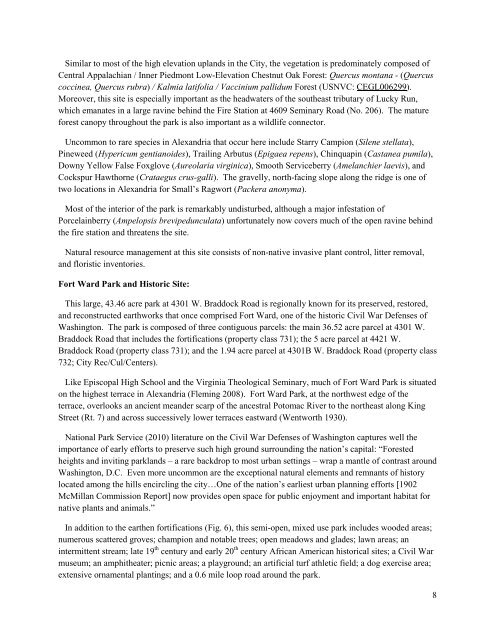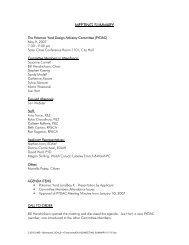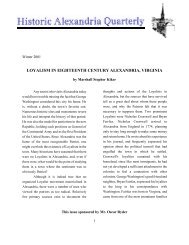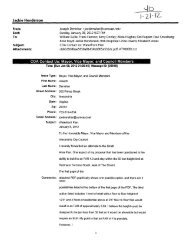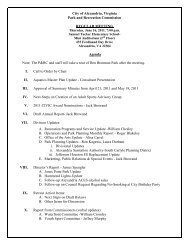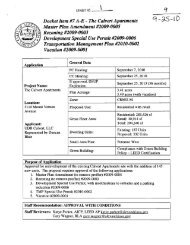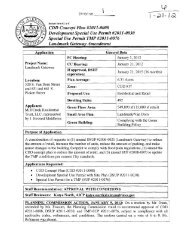Remnant Natural Areas in Parks, Waterways ... - City of Alexandria
Remnant Natural Areas in Parks, Waterways ... - City of Alexandria
Remnant Natural Areas in Parks, Waterways ... - City of Alexandria
You also want an ePaper? Increase the reach of your titles
YUMPU automatically turns print PDFs into web optimized ePapers that Google loves.
Similar to most <strong>of</strong> the high elevation uplands <strong>in</strong> the <strong>City</strong>, the vegetation is predom<strong>in</strong>ately composed <strong>of</strong><br />
Central Appalachian / Inner Piedmont Low-Elevation Chestnut Oak Forest: Quercus montana - (Quercus<br />
cocc<strong>in</strong>ea, Quercus rubra) / Kalmia latifolia / Vacc<strong>in</strong>ium pallidum Forest (USNVC: CEGL006299).<br />
Moreover, this site is especially important as the headwaters <strong>of</strong> the southeast tributary <strong>of</strong> Lucky Run,<br />
which emanates <strong>in</strong> a large rav<strong>in</strong>e beh<strong>in</strong>d the Fire Station at 4609 Sem<strong>in</strong>ary Road (No. 206). The mature<br />
forest canopy throughout the park is also important as a wildlife connector.<br />
Uncommon to rare species <strong>in</strong> <strong>Alexandria</strong> that occur here <strong>in</strong>clude Starry Campion (Silene stellata),<br />
P<strong>in</strong>eweed (Hypericum gentianoides), Trail<strong>in</strong>g Arbutus (Epigaea repens), Ch<strong>in</strong>quap<strong>in</strong> (Castanea pumila),<br />
Downy Yellow False Foxglove (Aureolaria virg<strong>in</strong>ica), Smooth Serviceberry (Amelanchier laevis), and<br />
Cockspur Hawthorne (Crataegus crus-galli). The gravelly, north-fac<strong>in</strong>g slope along the ridge is one <strong>of</strong><br />
two locations <strong>in</strong> <strong>Alexandria</strong> for Small’s Ragwort (Packera anonyma).<br />
Most <strong>of</strong> the <strong>in</strong>terior <strong>of</strong> the park is remarkably undisturbed, although a major <strong>in</strong>festation <strong>of</strong><br />
Porcela<strong>in</strong>berry (Ampelopsis brevipedunculata) unfortunately now covers much <strong>of</strong> the open rav<strong>in</strong>e beh<strong>in</strong>d<br />
the fire station and threatens the site.<br />
<strong>Natural</strong> resource management at this site consists <strong>of</strong> non-native <strong>in</strong>vasive plant control, litter removal,<br />
and floristic <strong>in</strong>ventories.<br />
Fort Ward Park and Historic Site:<br />
This large, 43.46 acre park at 4301 W. Braddock Road is regionally known for its preserved, restored,<br />
and reconstructed earthworks that once comprised Fort Ward, one <strong>of</strong> the historic Civil War Defenses <strong>of</strong><br />
Wash<strong>in</strong>gton. The park is composed <strong>of</strong> three contiguous parcels: the ma<strong>in</strong> 36.52 acre parcel at 4301 W.<br />
Braddock Road that <strong>in</strong>cludes the fortifications (property class 731); the 5 acre parcel at 4421 W.<br />
Braddock Road (property class 731); and the 1.94 acre parcel at 4301B W. Braddock Road (property class<br />
732; <strong>City</strong> Rec/Cul/Centers).<br />
Like Episcopal High School and the Virg<strong>in</strong>ia Theological Sem<strong>in</strong>ary, much <strong>of</strong> Fort Ward Park is situated<br />
on the highest terrace <strong>in</strong> <strong>Alexandria</strong> (Flem<strong>in</strong>g 2008). Fort Ward Park, at the northwest edge <strong>of</strong> the<br />
terrace, overlooks an ancient meander scarp <strong>of</strong> the ancestral Potomac River to the northeast along K<strong>in</strong>g<br />
Street (Rt. 7) and across successively lower terraces eastward (Wentworth 1930).<br />
National Park Service (2010) literature on the Civil War Defenses <strong>of</strong> Wash<strong>in</strong>gton captures well the<br />
importance <strong>of</strong> early efforts to preserve such high ground surround<strong>in</strong>g the nation’s capital: “Forested<br />
heights and <strong>in</strong>vit<strong>in</strong>g parklands – a rare backdrop to most urban sett<strong>in</strong>gs – wrap a mantle <strong>of</strong> contrast around<br />
Wash<strong>in</strong>gton, D.C. Even more uncommon are the exceptional natural elements and remnants <strong>of</strong> history<br />
located among the hills encircl<strong>in</strong>g the city…One <strong>of</strong> the nation’s earliest urban plann<strong>in</strong>g efforts [1902<br />
McMillan Commission Report] now provides open space for public enjoyment and important habitat for<br />
native plants and animals.”<br />
In addition to the earthen fortifications (Fig. 6), this semi-open, mixed use park <strong>in</strong>cludes wooded areas;<br />
numerous scattered groves; champion and notable trees; open meadows and glades; lawn areas; an<br />
<strong>in</strong>termittent stream; late 19 th century and early 20 th century African American historical sites; a Civil War<br />
museum; an amphitheater; picnic areas; a playground; an artificial turf athletic field; a dog exercise area;<br />
extensive ornamental plant<strong>in</strong>gs; and a 0.6 mile loop road around the park.<br />
8


